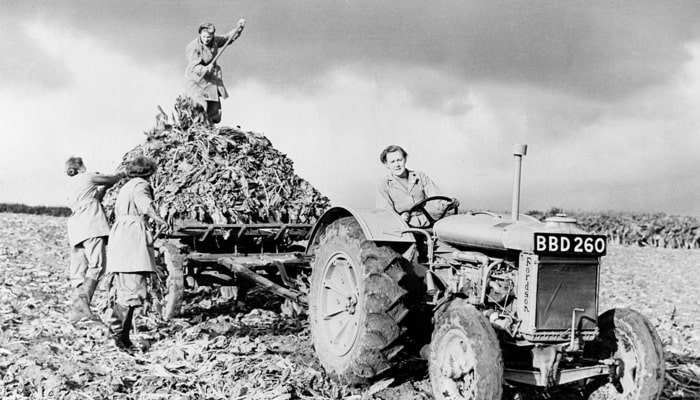
© Public Domain
British farmers played a crucial role in the war effort during the Great War, from 1914 to 1918, providing food for the nation. The war changed the face of British farming and the way farmers and growers produced food. German U-Boats cut off the usual trade routes, so the government relied on British farmers to feed the nation during this time of crisis. However, it wasn't easy, since many farmers had joined up and were away at the Western Front: more than 170,000 farmers from Britain fought in the trenches. In addition, the War Office requisitioned around half a million farm horses to serve on the frontline. Farms adapted the way they worked to ensure they could meet the challenges of food production for the nation. Labour shortages Conscription caused massive problems for the farming industry, as thousands of agricultural workers were ordered to join the Armed Forces. Farmers knew their role was critical to the war effort too, but a lack of unskilled labour was causing serious problems. Farmers pointed out that by taking ploughmen and blacksmiths into the army, they couldn't be easily replaced, and this would hinder the war effort on the Home Front. In response, the government set up the Women’s Land Army, employing more than 260,000 women as farm labourers to replace the men who had joined the Armed Forces. The government also introduced a voluntary rationing code in 1917, advising people to limit what they ate. The guide suggested a lunch of only one or two courses. More radical rationing was introduced in January 1918, after a German U-boat blockade left Britain's food supplies seriously depleted. First, sugar was rationed, followed by meat, cheese, butter and margarine. A good wheat harvest in 1918 helped to avert the food crisis, but sugar and butter remained rationed until 1920. Women's workforce The National Farmers' Union commissioned a report to assess the huge impact WW1 had on agriculture. It said in the absence of male farmhands, the thousands of extra women from the Women’s Land Army filled a huge void by working on farms. In addition, 66,000 troops had to return from the frontline to assist with the harvest. One major change was introducing tractors to complete the work of many pairs of hands. The government bought 400 tractors, manufactured by British Saunderson, in 1917. Britain also invested $3.2 million in American tractors, such as the Fordson. There were 6,000 tractors being used in Britain by 1918, changing the face of agriculture forever. In 1917, the government's "Ploughing Up" campaign led to an additional 2.5 million acres of land being used for cereal-growing to feed the nation. By the end of the war, in November 1918, farmers had grown an additional 1.7 million tonnes of potatoes, 915,000 tonnes of oats and 830,000 tonnes of wheat. Thanks to the work of Britain's farmers and crop-growers, the nation wasn't starved into submission. Hard work While women from rural areas, especially those from agricultural families, understood how hard the work was, for those joining the Land Army from urban areas, the physical demands were tough at first. The labourers had to work in all weathers and carried out work including heavy lifting. Before WW1, the usual assumption was that women wouldn't be able to cope with the physical demands of farm labouring. In the Victorian and Edwardian era, there was also a belief that farm work was "unfeminine". Farmers were often reluctant to take on women, but as more young men were conscripted, they had no choice. The war changed our perception of the work women were capable of doing, as they rose to the challenge and set about trying to increase food supplies. In addition, the government encouraged people to set aside land for allotments, not only in their own gardens, but also in municipal parks, where flower beds were transformed into vegetable gardens. At the end of the war, increasing mechanisation had become established in the agricultural industry, whereas before, everything had been either hand-held or horse-drawn, which was incredibly labour-intensive. The Women's Land Army was wound up in 1919 but was re-established in June 1939, just before the outbreak of World War 2. It played a vital role in the Dig for Victory campaign during WW2, before being finally disbanded in 1950. We will remember them On 11th November, at 11am: the Griggs Agri team will be observing the 2-minute silence, as we remember those who gave their lives so that we might live in freedom.




